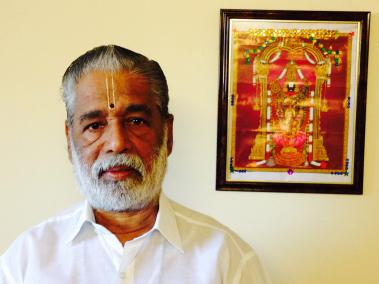Contribute
| In Conversation With M. Santhanakrishna Bhagavathar |
Ranjani Saigal
11/03/2016
“Nama Sankeertanam is the only way to reach God in the modern age†says Santhanakrishna Bhagavathar, Bhajana Sampradaya Maestro who is an expert in performing Radha Kalyanam, Seetha Kalyanam and other musical prayers in the authentic manner. He describes this tradition and his life as a Bhagavathar. He is also the father of Mahalingam (Mali), the Mridangam maestro from Norwood, MA.
Shri Santhanakrishna Bhagavathar is a leading exponent of the Bhajana Sampradaya tradition. He comes from a family of Bhagavathars (singers of the praise of Bhagwan or God) who for years have practiced and performed the Bhajana Sampradhaya.
Dakhshina Bharatha Sampradaya Bhajana is the tradition of Bhajans in India and as the name suggests particularly in South India. It's the collection of Kirtanas and Namavalis in specific order. Bodhendra Swamigal, Sridhara Ayyaval and Marudhanallur Sadguru Swamigal are considered to be the trinity of Gurus for this tradition.
Was music his profession?
“No. My professional life was spent working in the BCG Vaccine Labs where we worked on TB Vaccines. It was a very fulfilling career to be able to bring vaccines to prevent TB in children. However my passion was always in Bhajan singingâ€.
How did he learn this form of music?
“I never had any formal training in music. My father was a famous Bhagavathar and established the Radha Krishna Bhajana Samajam in Chennai where we used to perform a musical Radha Kalyanam. As far as I can remember I was always accompanying my father and uncle to Bhajanai. I just picked it up.â€
“The tradition of Bhajan singing has a very specific order of singing of bhajans. It begins with the Dhyana Slokam followed by the Sangraha Thodaya Mangalam (Thotakam - Beginning with a praise, Mangalam - End). Then we have Guru Dhyanam followed by Guru Abhangs. This is followed by Sadhu Keertanas . Then comes the , Jayadeva Ashtapadi and Narayana Teertha Krishna leela Tharangini.
Panchapati (Five songs in Telugu (Bhadrachala Ramadas), Kannada (Sri Purandara dasa), Sanskrit (Sri Sadasiva Brahmendral), Tamil (Sri Gopalakrishna Bharati) and compositions of Sri Tyagaraja, Kabir Das, Meera Bai, Tulsi das or Surdas Marathi Abhangs on Lord Panduranga are presented. We then have the Dyana keertanais (hymns on Gods). The pooja ends with Pooja Sampradaya Kritis,†said Shri Santhanakrishnan.
“ We then begin Divya namam. Deepa Pradakshinam where the singers will sing and dance around a lighted lamp. Finally we have dolotsavam (making God sleep), Anjaneya Keerthanai and Mangalamâ€
In a Radha Kalayanam or Seetha Kalyanam the singers actually enact the wedding of Radha and Krishna or Seetha and Rama by assigning parents to each side and reading the Lagnashtakam and even doing the tying of the Mangal Sutra.
The Bhajana Sampradayam can be considered a musical Yagna or a prayer with music doing all aspects of a Yagna, purification, invocation and prayer. “ For every aspect of the prayer there is a song, be is invoking the Lord, lighting the lamp, welcoming God into the altar or offering them clothes and food. It is all just a musical offeringâ€
Does he understand the lyrics considering it is in many different languages? “Not all. I do not even try to understand the lyrics. For me more than the lyrics the music just fills me with greatest happinessâ€.
Will the family continue the tradition? “ I am truly proud to say that my sons and my grandchildren are all very musical and interested in the tradition. My youngest granddaughter came with me to Chennai and was able to sing in a big sabha. It was a moment that filled my heart with prideâ€
Bhajan is not his only passion. Another surprising passion of his is fixing things. “There is not a thing in the home he cannot fix†says his son Mali. Just as we are sitting at his home, the neighbor drops in and says “Mama our microwave is not working properlyâ€. Coolly he replies, “ I will take a look at it and fix itâ€
Music and machines, his twin passions have helped him live a very fulfilling life. It was a true honor to meet this great Bhakta and mechanical innovator. We look forward to be part of his musical prayers in the future.
You may also access this article through our web-site http://www.lokvani.com/
